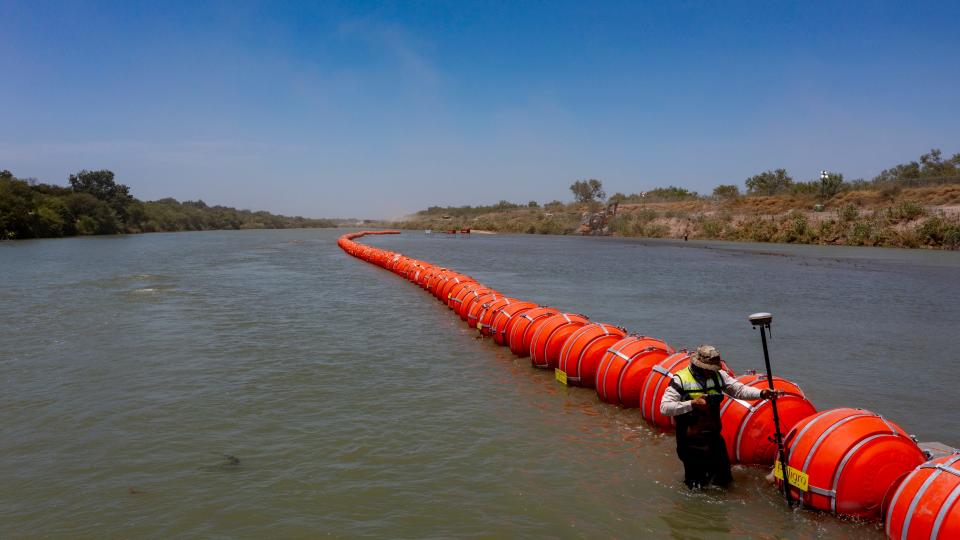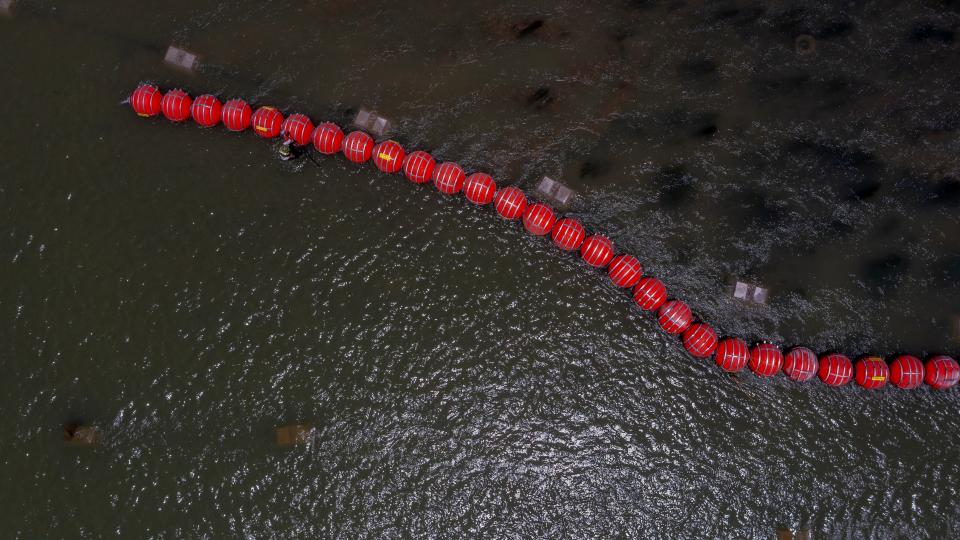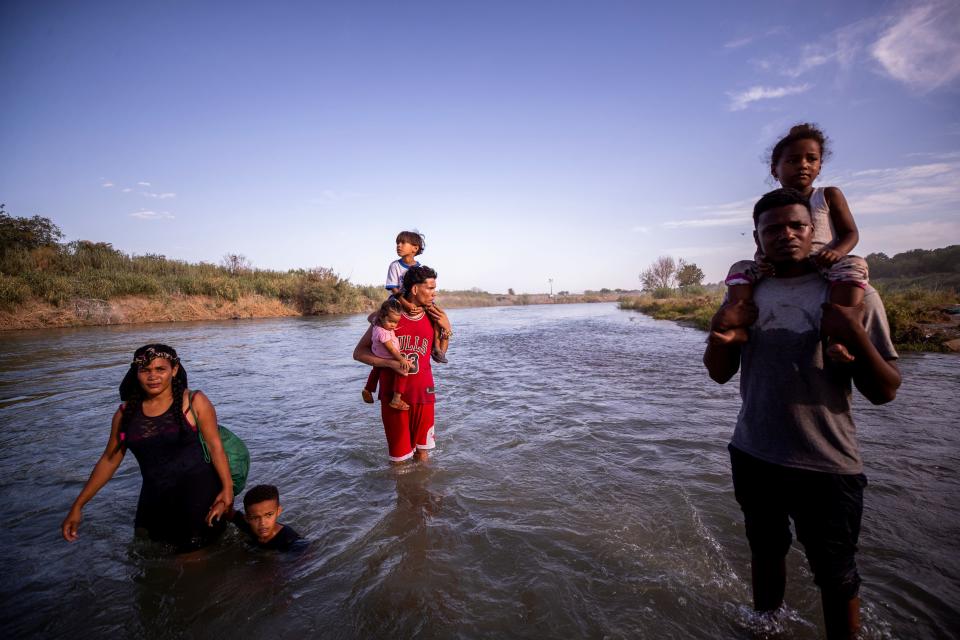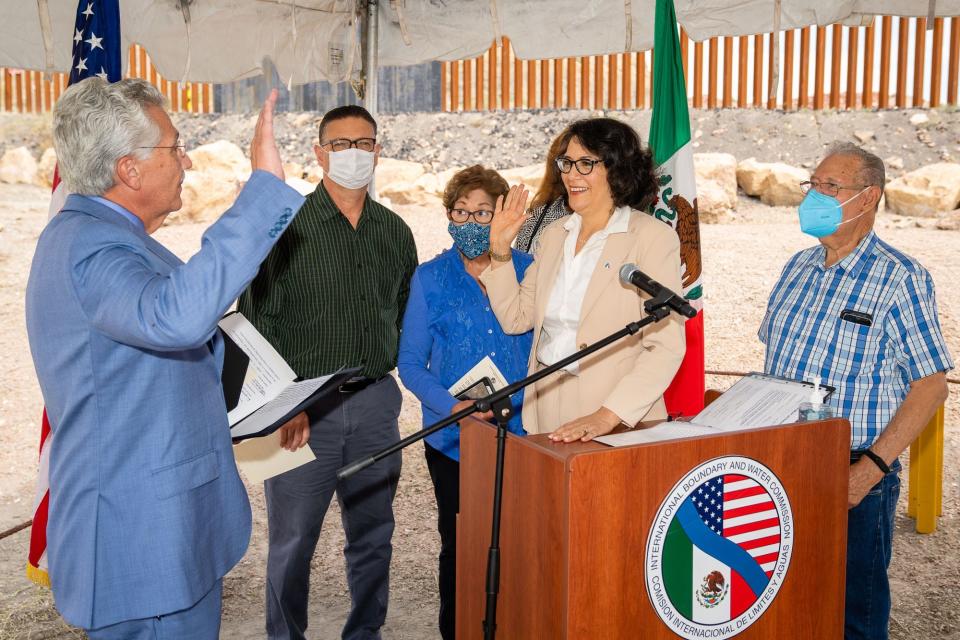Texas buoy barriers: Who governs the Rio Grande?
- Oops!Something went wrong.Please try again later.
Texas Gov. Greg Abbott's installation of a buoy barrier in the Rio Grande has raised red flags from immigrant advocates, an affected business owner and from Mexico, which claims Texas is violating human rights and the terms of an international treaty.
But who decides what goes on a river that is the international border?

Mexico filed a complaint over the orange barriers in June, placing the International Boundary and Water Commission, known as the Comisión Internacional de Límites y Aguas in Mexico, at the center of the international dispute.
More: How the buoys and other parts of Operation Lone Star affect life in Eagle Pass
What is the IBWC?
The International Boundary and Water Commission is the international body, jointly run by the United States and Mexico, that manages the Rio Grande — the flow of its waters and the demarcation of the international border.
The IBWC, established in 1889, explains its job this way: The commission is “responsible for applying the boundary and water treaties between the United States and Mexico and settling differences that may arise in their application.”
It's U.S. headquarters is in El Paso and its Mexico headquarters is in Juárez.
The commission isn't international window dressing. It's a hands-on, working agency that manages the Rio Grande day by day and is tasked with resolving disputes over the boundary. It operates and maintains flood control levees, international storage reservoirs, diversion dams and wastewater treatment plants on the U.S.-Mexico border.

Commissioners “meet frequently, alternating the place of meetings and are in almost daily contact with one another,” according to the IBWC.
More: 'It’s burning out there': Amid record heat, migrant deaths at border surge in Sunland Park
Who owns the Rio Grande in Texas?
The United States and Mexico share the waters of the Rio Grande.
The U.S.-Mexico border lies in the middle of the river from El Paso and Juárez to its delta at the Gulf of Mexico east of Brownsville and Matamoros in South Texas.
In Mexico, the federal government owns the river water.
In the U.S., in Texas, there are numerous private property owners along the border. The water resource is governed by a patchwork of federal and state laws, with surface and groundwater treated in Texas as distinct entities and governed as such. Local irrigation districts manage disbursements of river water allocations.
Does the U.S.-Mexico border move?
The border isn't a fixed line. Although it is demarcated on the U.S. side by steel fencing, that fencing isn't the actual borderline; the middle of the river is.
The Rio Grande marks the U.S.-Mexico boundary for 1,254 miles in Texas, according to the Texas Department of Transportation. In the past, the river has been known to move.

The original 1848 Treaty of Guadalupe-Hidalgo ended the U.S.-Mexico War and established the river as the international boundary. But the shifting river channel led the U.S. and Mexico to dispute — for a century — the location of the border in El Paso and Juárez.
A massive flood in 1864 moved an area called the Chamizal from Mexico to the U.S. side. It wasn't until 1963 that the two countries settled their differences, according to the National Park Service. The Chamizal became a National Memorial park in El Paso and a federally protected park in Juárez.
Who runs the IBWC?
An El Pasoan runs the U.S. section of the IBWC.
Today I had the privilege of attending Dr. Maria-Elena Giner’s swearing-in ceremony as Commissioner of the International Boundary and Water Commission.
Commissioner Giner is a proud daughter of immigrants with over 30 years of experience and I look forward to her leadership. pic.twitter.com/nu0AsMOOLc— Rep. Veronica Escobar (@RepEscobar) September 15, 2021
Maria-Elena Giner is the second woman, and the first Latina, to serve as IBWC commissioner. She grew up in El Paso, attended Loretto Academy and graduated with a Master of Business Administration from the University of Texas at El Paso.
President Joe Biden appointed Giner to the IBWC's top post in 2021.

What is Mexico saying about the Texas buoy barriers?
In June, Mexico’s government sent a diplomatic note to the U.S. State Department charging that Abbott's installation of razor wire and buoy barriers in the Rio Grande violated two key bilateral treaties governing the U.S.-Mexico border.
The barrier violates a 1944 International Water Treaty and a 1970 Boundary Treaty, according to Mexico. The boundary treaty states that both countries “shall prohibit the construction of works in its territory which … may cause deflection or obstruction of the normal flow of the river or of its flood flows,” Mexico’s foreign ministry said in a statement.
“That is why we are sending a territorial inspection team, through the International Boundary and Water Commission, to define where the buoys are located and see exactly what’s happening,” Foreign Minister Alicia Bárcena said during a July 14 media roundtable.
The El Paso Times confirmed a Mexican team surveyed the river Wednesday, July 20.
The team will “perform its topographic review to verify that they don’t incur into Mexican territory,” she said.
This article originally appeared on El Paso Times: Texas buoy barriers: Who governs the Rio Grande?

